Duplicate data method in mysql query table
This article mainly introduces the repeated data method in the mysql query table. Friends who need it can refer to
INSERT INTO hk_test(username, passwd) VALUES ('qmf1', 'qmf1'),('qmf2', 'qmf11') delete from hk_test where username='qmf1' and passwd='qmf1'
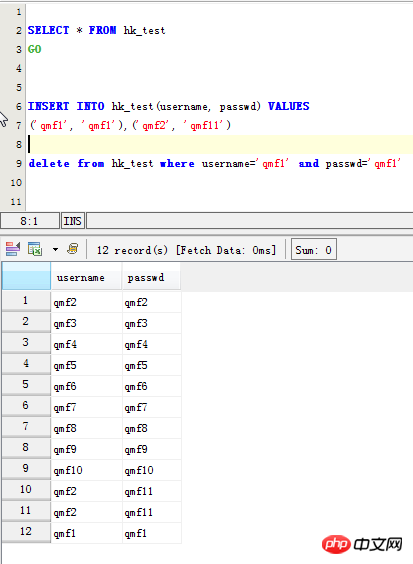
MySQL Query the duplicate data records in the table:
First check the duplicate original data:
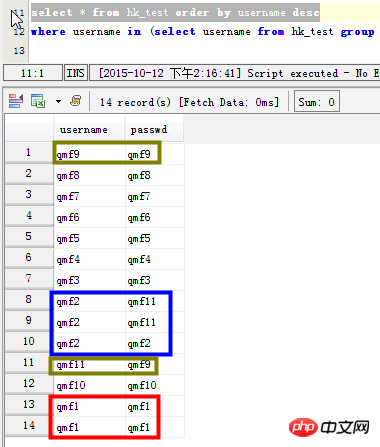
Scenario 1: List the data with repeated readings in the username field
select username,count(*) as count from hk_test group by username having count>1; SELECT username,count(username) as count FROM hk_test GROUP BY username HAVING count(username) >1 ORDER BY count DESC;
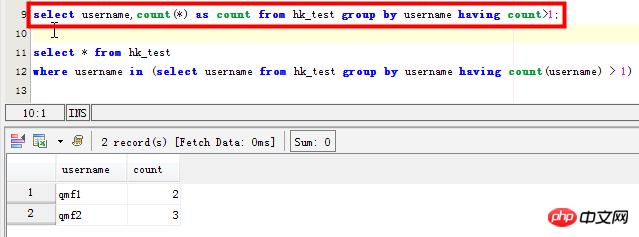
This method only counts the specific number of duplicates corresponding to the field
Scenario 2: List the specific references for duplicate records in the username field:
select * from hk_test where username in (select username from hk_test group by username having count(username) > 1) SELECT username,passwd FROM hk_test WHERE username in ( SELECT username FROM hk_test GROUP BY username HAVING count(username)>1) 但是这条语句在mysql中效率太差,感觉mysql并没有为子查询生成临时表。在数据量大的时候,耗时很长时间

Solution:
于是使用先建立临时表 create table `tmptable` as ( SELECT `name` FROM `table` GROUP BY `name` HAVING count(`name`) >1 ); 然后使用多表连接查询 SELECT a.`id`, a.`name` FROM `table` a, `tmptable` t WHERE a.`name` = t.`name`; 结果这次结果很快就出来了。 用 distinct去重复 SELECT distinct a.`id`, a.`name` FROM `table` a, `tmptable` t WHERE a.`name` = t.`name`;
Scenario 3: View records with duplicate fields: For example, username and passwd fields have duplicate records:
select * from hk_test a where (a.username,a.passwd) in (select username,passwd from hk_test group by username,passwd having count(*) > 1)

Scenario 4: Multiple fields in the query table are repeated at the same time:
select username,passwd,count(*) from hk_test group by username,passwd having count(*) > 1

MySQL查询表内重复记录 查询及删除重复记录的方法 (一) 1、查找表中多余的重复记录,重复记录是根据单个字段(peopleId)来判断 select * from people where peopleId in (select peopleId from people group by peopleId having count(peopleId)>1) 2、删除表中多余的重复记录,重复记录是根据单个字段(peopleId)来判断,只留有一个记录 delete from people where peopleId in (select peopleId from people group by peopleId having count(peopleId)>1) and min(id) not in (select id from people group by peopleId having count(peopleId)>1) 3、查找表中多余的重复记录(多个字段) select * from vitae a where (a.peopleId,a.seq) in (select peopleId,seq from vitae group by peopleId,seq having count(*)>1) 4、删除表中多余的重复记录(多个字段),只留有rowid最小的记录 delete from vitae a where (a.peopleId,a.seq) in (select peopleId,seq from vitae group by peopleId,seq having count(*) > 1) and rowid not in (select min(rowid) from vitae group by peopleId,seq having count(*)>1) 5、查找表中多余的重复记录(多个字段),不包含rowid最小的记录 select * from vitae a where (a.peopleId,a.seq) in (select peopleId,seq from vitae group by peopleId,seq having count(*) > 1) and rowid not in (select min(rowid) from vitae group by peopleId,seq having count(*)>1) (二) 比方说 在A表中存在一个字段“name”,而且不同记录之间的“name”值有可能会相同,现在就是需要查询出在该表中的各记录之间,“name”值存在重复的项; Select Name,Count(*) From A Group By Name Having Count(*) > 1 如果还查性别也相同大则如下: Select Name,sex,Count(*) From A Group By Name,sex Having Count(*) > 1 (三) 方法一 declare @max integer,@id integer declare cur_rows cursor local for select 主字段,count(*) from 表名 group by 主字段 having count(*) >; 1 open cur_rows fetch cur_rows into @id,@max while @@fetch_status=0 begin select @max = @max -1 set rowcount @max delete from 表名 where 主字段 = @id fetch cur_rows into @id,@max end close cur_rows set rowcount 0
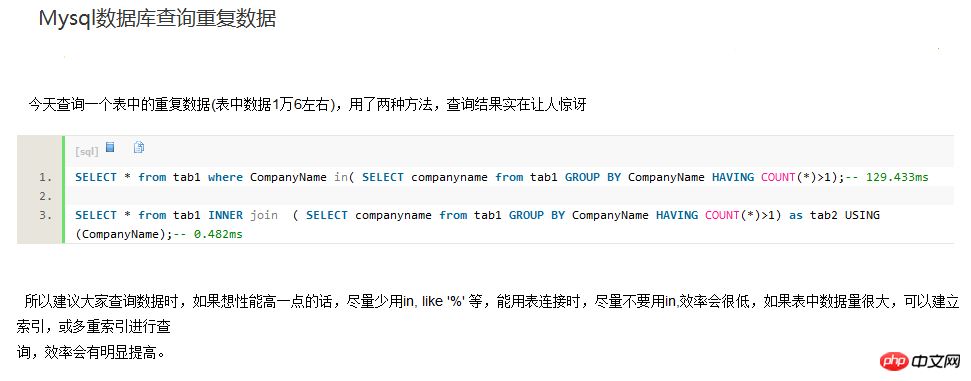
SELECT * from tab1 where CompanyName in( SELECT companyname from tab1 GROUP BY CompanyName HAVING COUNT(*)>1); -- 129.433ms SELECT * from tab1 INNER join ( SELECT companyname from tab1 GROUP BY CompanyName HAVING COUNT(*)>1) as tab2 USING(CompanyName); -- 0.482ms 方法二 有两个意义上的重复记录,一是完全重复的记录,也即所有字段均重复的记录,二是部分关键字段重复的记录,比如Name字段重复,而其他字段不一定重复或都重复可以忽略。 1、对于第一种重复,比较容易解决,使用 select distinct * from tableName 就可以得到无重复记录的结果集。 如果该表需要删除重复的记录(重复记录保留1条),可以按以下方法删除 select distinct * into #Tmp from tableName drop table tableName select * into tableName from #Tmp drop table #Tmp 发生这种重复的原因是表设计不周产生的,增加唯一索引列即可解决。 2、这类重复问题通常要求保留重复记录中的第一条记录,操作方法如下 假设有重复的字段为Name,Address,要求得到这两个字段唯一的结果集 select identity(int,1,1) as autoID, * into #Tmp from tableName select min(autoID) as autoID into #Tmp2 from #Tmp group by Name,autoID select * from #Tmp where autoID in(select autoID from #tmp2) 最后一个select即得到了Name,Address不重复的结果集(但多了一个autoID字段,实际写时可以写在select子句中省去此列) (四)查询重复 select * from tablename where id in ( select id from tablename group by id having count(id) > 1) 常用的语句 1、查找表中多余的重复记录,重复记录是根据单个字段(mail_id)来判断 代码如下 复制代码 SELECT * FROM table WHERE mail_id IN (SELECT mail_id FROM table GROUP BY mail_id HAVING COUNT(mail_id) > 1); 2、删除表中多余的重复记录,重复记录是根据单个字段(mail_id)来判断,只留有rowid最小的记录 代码如下 复制代码 DELETE FROM table WHERE mail_id IN (SELECT mail_id FROM table GROUP BY mail_id HAVING COUNT(mail_id) > 1) AND rowid NOT IN (SELECT MIN(rowid) FROM table GROUP BY mail_id HAVING COUNT(mail_id )>1); 3、查找表中多余的重复记录(多个字段) 代码如下 复制代码 SELECT * FROM table WHERE (mail_id,phone) IN (SELECT mail_id,phone FROM table GROUP BY mail_id,phone HAVING COUNT(*) > 1); 4、删除表中多余的重复记录(多个字段),只留有rowid最小的记录 代码如下 复制代码 DELETE FROM table WHERE (mail_id,phone) IN (SELECT mail_id,phone FROM table GROUP BY mail_id,phone HAVING COU(www.jb51.net)NT(*) > 1) AND rowid NOT IN (SELECT MIN(rowid) FROM table GROUP BY mail_id,phone HAVING COUNT(*)>1); 5、查找表中多余的重复记录(多个字段),不包含rowid最小的记录 代码如下 复制代码 SELECT * FROM table WHERE (a.mail_id,a.phone) IN (SELECT mail_id,phone FROM table GROUP BY mail_id,phone HAVING COUNT(*) > 1) AND rowid NOT IN (SELECT MIN(rowid) FROM table GROUP BY mail_id,phone HAVING COUNT(*)>1); 存储过程 declare @max integer,@id integer declare cur_rows cursor local for select 主字段,count(*) from 表名 group by 主字段 having count(*) >; 1 open cur_rows fetch cur_rows into @id,@max while @@fetch_status=0 begin select @max = @max -1 set rowcount @max delete from 表名 where 主字段 = @id fetch cur_rows into @id,@max end close cur_rows set rowcount 0 (一)单个字段 1、查找表中多余的重复记录,根据(question_title)字段来判断 代码如下 复制代码 select * from questions where question_title in (select question_title from people group by question_title having count(question_title) > 1) 2、删除表中多余的重复记录,根据(question_title)字段来判断,只留有一个记录 代码如下 复制代码 delete from questions where peopleId in (select peopleId from people group by peopleId having count(question_title) > 1) and min(id) not in (select question_id from questions group by question_title having count(question_title)>1) (二)多个字段 删除表中多余的重复记录(多个字段),只留有rowid最小的记录 代码如下 复制代码 DELETE FROM questions WHERE (questions_title,questions_scope) IN (SELECT questions_title,questions_scope FROM que(www.jb51.net)stions GROUP BY questions_title,questions_scope HAVING COUNT(*) > 1) AND question_id NOT IN (SELECT MIN(question_id) FROM questions GROUP BY questions_scope,questions_title HAVING COUNT(*)>1) 用上述语句无法删除,创建了临时表才删的,求各位达人解释一下。 代码如下 复制代码 CREATE TABLE tmp AS SELECT question_id FROM questions WHERE (questions_title,questions_scope) IN (SELECT questions_title,questions_scope FROM questions GROUP BY questions_title,questions_scope HAVING COUNT(*) > 1) AND question_id NOT IN (SELECT MIN(question_id) FROM questions GROUP BY questions_scope,questions_title HAVING COUNT(*)>1); DELETE FROM questions WHERE question_id IN (SELECT question_id FROM tmp); DROP TABLE tmp;
Find duplicate records in the mysql data table
There are more and more data in the mysql database, of course, exclude There is no duplicate data. When maintaining the data, I suddenly thought of deleting the redundant data and leaving valuable data.
The following sql statement can find all duplicate records in a table.
select user_name,count(*) as count from user_table group by user_name having count>1;
Parameter description:
user_name is the duplicate field to be found.
count is used to determine if it is greater than one, it is a duplicate.
user_table is the name of the table to be found.
group by is used to group
having is used to filter.
Change the parameters to the corresponding field parameters of your own data table. You can run it in Phpmyadmin or Navicat first. Check to see what data is duplicated, and then delete it in the database. You can also directly put the SQL statement in the background page to read news, and complete it into a list of duplicate data. If there are duplicates, you can directly delete them.
The effect is as follows:
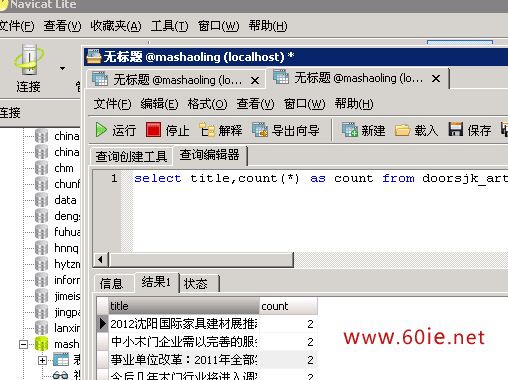
Disadvantages: The disadvantage of this method is that when the amount of data in your database is large, the efficiency is very low. I The Navicat test was used. The data volume is not large and the efficiency is very high. Of course, the website also has other SQL statements that repeatedly query data. Draw inferences from one example and learn from other cases. Please study carefully and find a query statement suitable for your website.
The above is the detailed content of Duplicate data method in mysql query table. For more information, please follow other related articles on the PHP Chinese website!

Hot AI Tools

Undresser.AI Undress
AI-powered app for creating realistic nude photos

AI Clothes Remover
Online AI tool for removing clothes from photos.

Undress AI Tool
Undress images for free

Clothoff.io
AI clothes remover

Video Face Swap
Swap faces in any video effortlessly with our completely free AI face swap tool!

Hot Article

Hot Tools

Notepad++7.3.1
Easy-to-use and free code editor

SublimeText3 Chinese version
Chinese version, very easy to use

Zend Studio 13.0.1
Powerful PHP integrated development environment

Dreamweaver CS6
Visual web development tools

SublimeText3 Mac version
God-level code editing software (SublimeText3)

Hot Topics
 1667
1667
 14
14
 1426
1426
 52
52
 1328
1328
 25
25
 1273
1273
 29
29
 1255
1255
 24
24
 MySQL's Role: Databases in Web Applications
Apr 17, 2025 am 12:23 AM
MySQL's Role: Databases in Web Applications
Apr 17, 2025 am 12:23 AM
The main role of MySQL in web applications is to store and manage data. 1.MySQL efficiently processes user information, product catalogs, transaction records and other data. 2. Through SQL query, developers can extract information from the database to generate dynamic content. 3.MySQL works based on the client-server model to ensure acceptable query speed.
 Explain the role of InnoDB redo logs and undo logs.
Apr 15, 2025 am 12:16 AM
Explain the role of InnoDB redo logs and undo logs.
Apr 15, 2025 am 12:16 AM
InnoDB uses redologs and undologs to ensure data consistency and reliability. 1.redologs record data page modification to ensure crash recovery and transaction persistence. 2.undologs records the original data value and supports transaction rollback and MVCC.
 MySQL's Place: Databases and Programming
Apr 13, 2025 am 12:18 AM
MySQL's Place: Databases and Programming
Apr 13, 2025 am 12:18 AM
MySQL's position in databases and programming is very important. It is an open source relational database management system that is widely used in various application scenarios. 1) MySQL provides efficient data storage, organization and retrieval functions, supporting Web, mobile and enterprise-level systems. 2) It uses a client-server architecture, supports multiple storage engines and index optimization. 3) Basic usages include creating tables and inserting data, and advanced usages involve multi-table JOINs and complex queries. 4) Frequently asked questions such as SQL syntax errors and performance issues can be debugged through the EXPLAIN command and slow query log. 5) Performance optimization methods include rational use of indexes, optimized query and use of caches. Best practices include using transactions and PreparedStatemen
 MySQL vs. Other Programming Languages: A Comparison
Apr 19, 2025 am 12:22 AM
MySQL vs. Other Programming Languages: A Comparison
Apr 19, 2025 am 12:22 AM
Compared with other programming languages, MySQL is mainly used to store and manage data, while other languages such as Python, Java, and C are used for logical processing and application development. MySQL is known for its high performance, scalability and cross-platform support, suitable for data management needs, while other languages have advantages in their respective fields such as data analytics, enterprise applications, and system programming.
 MySQL: From Small Businesses to Large Enterprises
Apr 13, 2025 am 12:17 AM
MySQL: From Small Businesses to Large Enterprises
Apr 13, 2025 am 12:17 AM
MySQL is suitable for small and large enterprises. 1) Small businesses can use MySQL for basic data management, such as storing customer information. 2) Large enterprises can use MySQL to process massive data and complex business logic to optimize query performance and transaction processing.
 How does MySQL index cardinality affect query performance?
Apr 14, 2025 am 12:18 AM
How does MySQL index cardinality affect query performance?
Apr 14, 2025 am 12:18 AM
MySQL index cardinality has a significant impact on query performance: 1. High cardinality index can more effectively narrow the data range and improve query efficiency; 2. Low cardinality index may lead to full table scanning and reduce query performance; 3. In joint index, high cardinality sequences should be placed in front to optimize query.
 MySQL for Beginners: Getting Started with Database Management
Apr 18, 2025 am 12:10 AM
MySQL for Beginners: Getting Started with Database Management
Apr 18, 2025 am 12:10 AM
The basic operations of MySQL include creating databases, tables, and using SQL to perform CRUD operations on data. 1. Create a database: CREATEDATABASEmy_first_db; 2. Create a table: CREATETABLEbooks(idINTAUTO_INCREMENTPRIMARYKEY, titleVARCHAR(100)NOTNULL, authorVARCHAR(100)NOTNULL, published_yearINT); 3. Insert data: INSERTINTObooks(title, author, published_year)VA
 MySQL vs. Other Databases: Comparing the Options
Apr 15, 2025 am 12:08 AM
MySQL vs. Other Databases: Comparing the Options
Apr 15, 2025 am 12:08 AM
MySQL is suitable for web applications and content management systems and is popular for its open source, high performance and ease of use. 1) Compared with PostgreSQL, MySQL performs better in simple queries and high concurrent read operations. 2) Compared with Oracle, MySQL is more popular among small and medium-sized enterprises because of its open source and low cost. 3) Compared with Microsoft SQL Server, MySQL is more suitable for cross-platform applications. 4) Unlike MongoDB, MySQL is more suitable for structured data and transaction processing.




